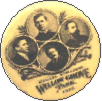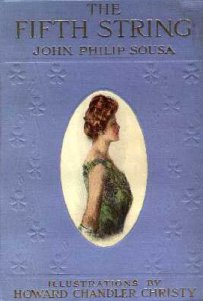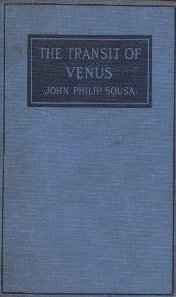

| Home |
| Programs & Schedules |
| Performers |
| A Performance |
| Learn More |
| Items of Interest |
| A Walk in the Grove |
|
The famous bandmaster-composer wrote five books which had a large sale. - Cedric Larson in an article in the Etude Magazine in August 1941 wrote an analysis and critique of Sousa  Larson characterizes the writing of The Fifth String as : "melodramatic and artificial - "starchy formality pervades..." The novelette appeared in 1902, a little book of one hundred and twenty-five pages bearing the title, The Fifth String. The book went through various editions and total sales within a few years passed the fifty-five thousand mark, not bad for a "first." The volume contained six full-page illustrations by Howard Chandler Christy, and sold for $1.25. One announcement of the book graphically read in part: "The Fifth String has a strong and clearly defined plot which shows in its treatment the author's artistically sensitive temperament and his tremendous dramatic power. It is a story of a marvelous violin, of a wonderful love and of a strange temptation." 1905 - Pipetown Sandy In style, word usage and plot, the book is a considerable advance over "The Fifth String." "Pipetown Sandy" seems as unpretentious and natural as its predecessor was melodramatic and artificial. The narrative moves swiftly and is largely conversational in form. Its descriptive portions ring true, for the author was discussing an environment of which he knew every foot. The characters are convincing, flesh and blood creations. The rubicund grocer, who quotes Shakespeare and woos a comely widow, evokes many an honest laugh; and those especially interested in Sousa himself find the characterization of Gilbert Franklin and his family well worth studying. All copies of the Sousa juvenile novel, which the writer has encountered, are well thumbed and usually rebound-unmistakable testimonials of a book's popularity. 1910 - Through the Year with Sousa Under each day of the year was given a selection chosen by the "March King" from one of his own works; its form might be a few bars of music from an opera, a martial air or other musical composition, or excerpts from his songs, verses and writings. Under each date was entered the birthday of a famous musician. 1920: - The Transit of Venus  Almost forty years earlier, when young Sousa was conducting the Marine Band under the Secretary of the Navy, Congress appointed a body known as the United States Commission on the Transit of Venus. This Commission functioned under the supervision of the Secretary of the Navy, and its purpose was to photograph the passage of Venus' shadow-cone over the earth, an astronomical phenomenon which occurred in 1882 and will not happen again until 2004. Various parties sailed for the southern tips of Africa, South America and other places "down under" to photograph the "transit of Venus."
Almost forty years earlier, when young Sousa was conducting the Marine Band under the Secretary of the Navy, Congress appointed a body known as the United States Commission on the Transit of Venus. This Commission functioned under the supervision of the Secretary of the Navy, and its purpose was to photograph the passage of Venus' shadow-cone over the earth, an astronomical phenomenon which occurred in 1882 and will not happen again until 2004. Various parties sailed for the southern tips of Africa, South America and other places "down under" to photograph the "transit of Venus."1928 - Marching Along (Sousa’s Autobiography) 384 pages $5.00 In the scope of this 384-page narrative, the author traces his musical progress year by year. Its pages are studded with numberless anecdotes about his dealings with the great, near great, and his orchestral triumphs. Flashes of humor lighten many passages, and the writer has a ready eye for presenting dramatic situations and highlights of his life. Two fairly long excerpts from "Pipetown Sandy" are given in "Marching Along": an eight-page description in chapter two of the Grand Review in Washington after the Civil War; and a twelve-stanza poem called "The Feast of the Monkeys" reprinted in the thirteenth chapter, and called by the writer "nonsense verses which have served to amuse my own grand-children" (about four and a half pages in length). In his biographical narrative Sousa mentions "The Fifth String" in various places, but nowhere, save in the appended bibliography of all his musical and literary creations, does reference to "The Transit of Venus" appear. Abbe Niles' opinion of the book appeared in The Bookman in August, 1928: "The writer hoped for more than he found in 'Marching Along' . . . This is more a scrapbook than an autobiography: a mass of testimonials, scrolls of honor from this city and that, commands from royalty, press reviews, public correspondence on ancient controversies, photographs, statistics of miles traveled, countries seen, and attendance; anecdotes upon anecdotes, all tied together with a loose and slender thread of narrative and comment. In short, there is too little of Sousa and too much about him." The nation still needs a sympathetic and intimate interpretation of one of its musical geniuses. In looking over his Officers' Training Record by special permission at the Navy Department in Washington, the writer was surprised to note that the bandmaster listed his occupation on the official record as "Composer, Novelist, Conductor of Sousa Band" in precisely that order. He was in his sixty-third year at the time, so we may conclude that he cherished writing in the evening of his life as one of his serious achievements.
|